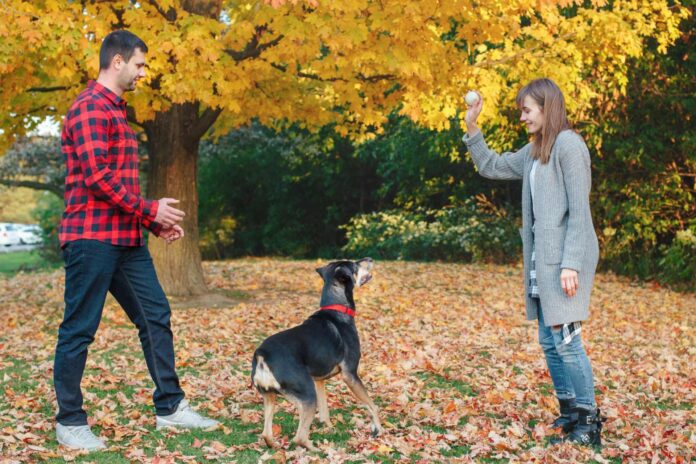I am often asked what the secret to training my dogs is. And to be honest, it took me a while to figure it out, but simply put, consistency in dog training is the secret. If you want to call it that.
So lets discusses the importance of consistency in dog training, and how it fosters good behavior, reduces stress, and strengthens the bond between dogs and their owners.
The Crucial Role of Consistency in Dog Training: Building Confidence and Adaptability
If you are a frequent visitor to my site, you know that I often comment on the fact that consistency in dog training cannot be overstated. It forms the bedrock upon which effective training is built, serving as the key to unlocking a dog’s potential and ensuring a harmonious relationship between pet and owner.
Consistency in dog training encompasses everything from the commands we use to the rewards we offer, creating a clear and reliable framework within which dogs can learn. This approach not only reinforces positive behavior but also significantly reduces the likelihood of confusion or misunderstanding.
By maintaining a consistent training regimen, we provide our dogs with the stability and predictability that are essential for their psychological well-being. Dogs, inherently creatures of habit, find comfort and security in knowing what to expect from their environment and their human companions.
Consistency in dog training ensures effective learning and a strong owner-pet bond.
This sense of familiarity is crucial in fostering their confidence and facilitating a more effective learning process. The importance of consistency extends beyond the immediate learning phase, impacting a dog’s ability to adapt and thrive in various situations.
For instance, a dog that has been consistently trained to respond to a specific command in a variety of settings will demonstrate greater reliability and adaptability.
This adaptable behavior is particularly beneficial in situations that might otherwise cause stress or anxiety, such as moving to a new home, traveling, or interacting with unfamiliar people or pets.
In essence, the consistent application of training principles not only aids in the development of desirable behaviors but also equips dogs with the resilience to navigate life’s uncertainties with confidence.
By recognizing and adhering to the critical role of consistency in dog training, we lay the foundation for a rewarding and enduring relationship with our canine companions.

The Impact of Consistent Training Schedules on Dogs
Establishing a consistent training schedule is more than just a methodological approach; it serves as a communication bridge between dogs and their owners. By adhering to a predictable routine and employing uniform commands, owners signal to their dogs what is expected of them, fostering an environment where dogs can thrive with clear guidelines.
This clarity is indispensable, especially considering that dogs, much like humans, seek to understand their role within the family dynamic. An illustrative example of the profound impact of consistency can be observed in the training of service dogs, where precise routines and commands are not just beneficial but crucial.
Consistent training routines create a clear, stress-free environment, enhancing dog’s learning and well-being.
These dogs must perform tasks that require a high degree of reliability, and the foundation of this reliability is built on the bedrock of consistency. Furthermore, the psychological well-being of dogs is significantly enhanced when they live in predictable environments.
Dogs are creatures of habit, and they find comfort in knowing what to expect from their day-to-day interactions. Consistent training routines and cues eliminate guesswork, significantly reducing stress and anxiety levels in dogs.
This predictability allows dogs to develop a sense of security, which in turn, makes the training process a positive and enjoyable experience for them. When dogs are less stressed and more comfortable, they are better able to focus on learning and responding to training, thereby accelerating their progress and enhancing the overall effectiveness of the training efforts.

Family Unity in Dog Training
In the realm of dog training, the involvement and consistency of each family member play a pivotal role in the success of the training process. When every person in the household utilizes the same commands and reinforces the same behaviors, it establishes a clear and coherent communication channel between the dog and its human pack.
For example, if one family member uses “down” to instruct the dog to lie down, while another uses “lay,” this inconsistency can lead to confusion for the dog, impeding its learning progress.
Consistent use of commands and cues across all family members ensures that the dog does not receive mixed signals, allowing for a more efficient and effective training experience.
Unified family involvement in dog training ensures clarity, efficiency, and strengthens relationships
Moreover, the collective effort in maintaining consistency in training fosters a stronger, more unified bond not only between the dog and individual family members but also among the family members themselves.
Engaging in training sessions together can be a fun and rewarding activity that enhances the relationship with the dog while simultaneously encouraging teamwork and communication within the family.
This shared responsibility helps to ensure that the dog perceives everyone as part of its pack, recognizing and responding to commands uniformly from all members.
This unified approach not only streamlines the training process but also contributes to a more peaceful and cohesive household, where both the dog and its human companions thrive in mutual understanding and respect.household where every member, furry or not, feels valued and understood.
Enhancing Dog Training with Consistency and Positive Reinforcement
Consistency in dog training is not just about sticking to a schedule; it involves the strategic use of positive reinforcement to shape desired behaviors. A powerful example of this strategy in action is the use of treats or praise immediately following a correctly executed command.
This timely reinforcement helps dogs make a clear connection between their action and the positive outcome, significantly increasing the likelihood of the behavior being repeated. It’s essential to apply this principle uniformly across all training scenarios to avoid sending mixed signals to your dog.
Consistent, positive reinforcement and short, daily sessions improve learning and behavior generalization in dogs.
Moreover, the structure and frequency of training sessions play a critical role in reinforcing learning. Short, regular training sessions are generally more beneficial than irregular, lengthy ones.
Consistent, daily training sessions of 15 minutes can dramatically improve a dog’s learning curve compared to hour-long sessions that occur sporadically. This consistency keeps the dog engaged and prevents the overload of information, making each training session more productive.
Additionally, applying the same commands and cues across various settings helps your dog understand that the rules apply everywhere, not just at home or in the training field. This approach aids in the generalization of behaviors, ensuring that your dog behaves appropriately regardless of the environment.
The Impact of Inconsistent Dog Training on Behavior and Well-being
Inconsistent training can severely impact a dog’s psychological well-being and behavior, often manifesting in negative ways such as disobedience, aggression, and heightened anxiety levels.
For instance, a dog that receives mixed signals about whether jumping on people is acceptable may continue this undesirable behavior, leading to confusion and potential social problems.
This inconsistency not only confuses the dog but can also lead to frustration and stress, as the animal struggles to understand the boundaries and expectations set by their owner.
Such confusion is counterproductive to the training process, making it increasingly challenging for dogs to learn and adhere to desired behaviors.
Inconsistency in training leads to confusion, stress, and a weakened bond between dog and owner.
Moreover, when there is a lack of consistency in commands, rewards, and disciplinary actions, it can significantly hinder a dog’s ability to trust their owner, thereby weakening the bond between them.
This breakdown in communication can exacerbate behavioral problems, making the dog more difficult to manage and negatively affecting their overall quality of life. For example, a dog that is inconsistently reprimanded for the same misbehavior may become anxious or act out more aggressively, not understanding what is expected of them from one moment to the next.
Such outcomes underline the importance of maintaining consistency in training approaches to foster a healthy, obedient, and happy canine companion.
Building Trust Through Consistency in Dog Training
The cornerstone of any successful dog training regimen is the establishment of a robust and trusting relationship between the dog and its owner. This rapport is significantly strengthened through consistent training practices.
When training is systematic and predictable, it fosters clear communication, enabling dogs to understand what is expected of them with greater ease.
For example, consistently rewarding a dog for sitting on command reinforces the desired behavior, making it more likely for the dog to respond correctly in a variety of settings.
This consistency in response not only demonstrates the dog’s understanding and compliance but also the effectiveness of a steadfast training approach.
Consistent training strengthens trust and communication, enhancing obedience, well-being, and owner-dog bonds.
Moreover, the benefits of consistency extend beyond mere obedience; they play a crucial role in enhancing the dog’s overall well-being and happiness.
A dog that receives consistent feedback and understands boundaries feels more secure and confident. Such an environment of predictability helps to alleviate stress and anxiety in dogs, contributing to a happier, more balanced temperament.
This is particularly evident in the way dogs react to consistent positive reinforcement; they not only learn what behaviors are rewarded but also develop a deeper trust in their owners. This trust is the foundation of a strong and enduring bond that positively impacts the dog’s social and emotional health.

The Science of Dog Training: Reward-Based Methods Prevail
The evolving scientific understanding of canine behavior and training methodologies has increasingly emphasized the effectiveness and ethical dimensions of reward-based training over aversive methods.
Studies indicate that dogs trained with positive reinforcement not only learn commands more effectively but also develop a more optimistic association with the training process itself. This is because reward-based methods focus on encouraging and rewarding the desired behavior, rather than punishing the undesired.
For example, when a dog training sits on command and receives a treat, it is more likely to repeat the behavior in anticipation of more rewards, thereby reinforcing the behavior through a positive feedback loop. This contrast sharply with aversive methods, which can lead to increased stress and potential behavioral issues in dogs.
Scientific studies favor consistent, reward-based training for effective learning and positive dog behavior.
Moreover, consistency in the application of these reward-based techniques is paramount. When commands and rewards are given consistently, dogs are better able to understand what is expected of them, leading to faster learning and more reliable behavior in a variety of situations.
Consistent training not only aids in reinforcing desired behaviors but also helps in shaping long-term habits that are beneficial for both the dog and the owner. The predictability of rewards following specific behaviors fosters an environment of trust and security, further enhancing the dog’s learning capacity and well-being.
Thus, the scientific lens through which we view dog training today strongly advocates for consistent, positive reinforcement methods as the most effective and humane approach to training.
Conclusion: The Crucial Role of Consistency in Dog Training
The path to successful dog training is paved with the steadfast dedication to consistency. It’s a journey that demands patience, a deep understanding of canine behavior, and an unwavering commitment to applying the same methods and routines day after day.
This approach not only facilitates a smoother learning process but also significantly enriches the relationship between dog and owner. Through consistency, we lay down a foundation of clear communication, where commands, expectations, and rewards are unmistakably understood by our canine companions.
An exemplary case of this is the use of a specific command like “sit.” By consistently using “sit” and rewarding the desired behavior every time, dogs quickly learn what is expected of them, leading to faster learning and less frustration for both parties.
Consistency in dog training fosters clear communication, trust, and a strong bond between dog and owner.
Moreover, consistency serves as the cornerstone of trust and mutual respect in the owner-dog relationship. When dogs know what to expect from their owners, they feel more secure and are more likely to respond positively to training cues.
This predictability helps to mitigate any potential stress or anxiety associated with learning new behaviors, making the training process not only more effective but also more enjoyable for the dog.
In essence, maintaining consistency in dog training goes beyond mere obedience—it fosters a deep, enduring bond that enhances the well-being of both the dog and the owner. As we embrace the principles of consistency, we unlock the door to a harmonious and fulfilling life with our beloved pets.
Related Topics:
Creating Harmony: Mastering Dog Training with Positive Reinforcement Techniques
Mastering Reward-Based Training: Optimizing Treats and Praise for Dog Training




